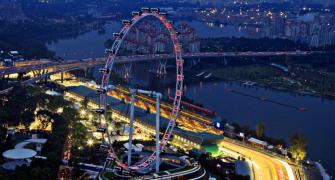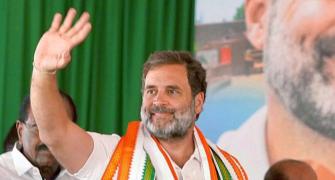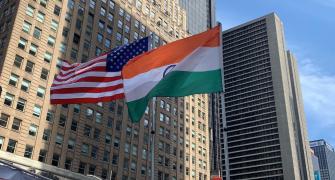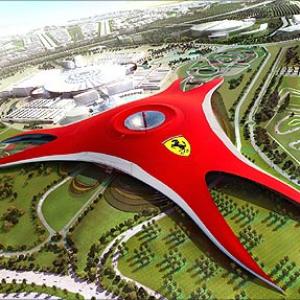Amusements parks in India are coming of age, but there is a lot to learn from international payers like Genting, Sentosa, and Disney says Rajiv Aneja.

Higher disposable incomes, changing travel habits and aggressive marketing by operators has fuelled the demand for newer attractions and experiences to satisfy ever-changing recreational needs.
Photograph: @iHrtihik/Twitter.
For centuries, amusement and theme parks have been offering an exciting escape from real life. Thrilling rides, entertaining shows and enchanting activities create a wonderland that appeals to all age groups.
With the phenomenal growth in the recreation and leisure industry in the last couple of decades, one area that has once again taken the fancy of investors, tourism operators and travellers alike across India is amusement parks.
The concept of outdoor pleasure activities is steadily moving up one's 'wish list', and is no longer considered a luxury or a domain of select few.
Higher disposable incomes, changing travel habits and aggressive marketing and promotions by operators has further fuelled the demand for newer attractions and experiences to satisfy ever-changing recreational needs.
Global scenario
Though a relatively emerging field in the Indian tourism product line, amusement or theme parks have a long and interesting history globally.
They began as European fairs, pleasure gardens and large picnic areas meant for recreation.
Through the 18th and 19th centuries, these evolved into places of entertainment for the masses, where the public could view shows, acrobatics, conjuring and juggling and participate in competitions. Lake Compounce in Connecticut opened in 1846 and is considered the oldest continuously-operating amusement park in North America.
Labour laws during industrialisation in Europe, which mandated weekly off for workers, increased connectivity through railways and increasing disposable income were key engines of growth of the industry.
By the early 1900s, hundreds of amusement parks were operating in the United States and Canada. This was considered the Golden Age of amusement parks, and continued till the late 1920s.
The Great Depression of the 1930s and World War II during the 1940s saw the decline of the amusement park industry. War caused the affluent urban population to move to the suburbs, television became a source of entertainment, and families went to amusement parks less often.
Once war clouds dissipated, the good times started again and the amusement park industry flourished.
The first theme parks emerged in the mid-20th century with the opening of Santa Claus Land in Indiana in 1946 and the popular Disneyland in California in 1955. Theme parks like SeaWorld Orlando in Florida and Universal Studios Hollywood in California followed.
Countless smaller chain ventures like the Six Flags parks, Cedar Fair parks chain, and Legoland exist across the United States and around the world.
India scenario
Asia is currently one of the emerging regions for theme park markets in the world.
With meltdown and saturation creeping into Americas and Europe, focus has shifted to countries like China, Korea, Japan and now India, which are showing robust growth in investments in new parks, product innovation, capacity enhancement and geographical expansion
As for India, more than 150 theme parks have opened since Appu Ghar, India's first, was launched in Delhi in 1984.
Today, the top three theme parks are Essel World in Mumbai, Nicco Park in Kolkata, and Ramoji Film City in Hyderabad, which all attract more than 1 million visitors annually.
Other big players that have made an entry with a bang include the Wonderla chain in Kochi, Bengaluru and Hyderabad; Kingdom of Dreams in Gurgaon, and Adlabs Imagica in Maharashtra.
India has about 150 amusement parks for a population of 1,200 million people. Total annual footfall are estimated to be about 50 million.
In comparison, the US has around 400 amusement parks for a population of 300 million.
The Indian amusement park segment is still valued at $400 million, compared to the $25 billion global amusement park segment, which translates into immense growth opportunities.
The types of parks are mostly divided into three categories: theme parks, water parks and FECs (family entertainment centers).
The revenue model in India is more or less on global patterns, which follows a format of revenue coming in from entry tickets, food and beverages, advertisements and sponsorships, merchandising and souvenirs, event handling and the rest coming in from miscellaneous services like parking, upcharge etc. Being a highly capital intensive sector, the gestation period is longer and needs long staying power.
The demand for amusement parks in India has increased over the past few years because of the unique experiences it offers. As per reports, the Indian theme park industry grew in double digits in 2016 to reach ₹3,000 crore.
The industry, however, has long way to go to reach the global level. Many estimates show that this sector will grow at a healthy 20 per cent to become ₹7,000 crore industry in the next 5-6 years and attract ₹15,000-20,000 crore in investments over the next 4-5 years.
Way forward
For the amusement sector to achieve this ambitious goal, there is urgent need to address issues plaguing the sector.
Some of the key challenges faced by sector are huge domestic traffic but still so low footfall, not appealing enough to foreign tourists, limited product range, lack of innovation and upgradation and lack of new age marketing and positioning tools to expand visitor base.
There is a lot to learn from international payers like Genting, Sentosa, Disney, etc, who have leveraged the customer analytics and data management to efficiently pave way for making themselves a must see attraction at the destination or even becoming a destination in itself.
Ultimately, it is all about the experience and the options or choices available for the potential visitor are ever increasing. Unless we offer them a journey that is engaging and different we may not get where we want to be.
Rajiv Aneja has over two decades of experience in the travel and tourism industry.










